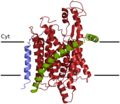Sec61
Sec61 is a protein complex integral to the endoplasmic reticulum (ER) membrane, playing a crucial role in the translocation of polypeptides into the ER. This complex is essential for the proper functioning of cells, as it facilitates the insertion of proteins into the ER membrane or their translocation across the ER membrane into the lumen. The Sec61 complex is highly conserved across eukaryotes and is also found in a similar form in prokaryotes, where it is known as the SecYEG complex.
Structure[edit]
The Sec61 complex is composed of three subunits: Sec61α, Sec61β, and Sec61γ. The α subunit forms the channel through which polypeptides are translocated. The β and γ subunits, while smaller, are essential for the structural integrity and function of the complex. The Sec61 complex forms a channel that is gated and can open to allow the passage of polypeptide chains into the ER lumen or integrate them into the ER membrane.
Function[edit]
The primary function of the Sec61 complex is to mediate the co-translational translocation of proteins into the ER. This process is essential for proteins that are destined for secretion, membrane insertion, or residence within the endomembrane system. The Sec61 complex interacts with the ribosome to form a ribosome-Sec61 complex, facilitating the direct transfer of nascent proteins into the ER. Additionally, the Sec61 complex is involved in the post-translational translocation of certain proteins and the integration of membrane proteins into the ER membrane.
Regulation[edit]
The activity of the Sec61 complex is regulated by various factors, including the binding of the ribosome, the presence of signal sequences on the nascent polypeptide, and interactions with other protein complexes such as the Signal Recognition Particle (SRP) and the translocon-associated protein complex (TRAP). Additionally, the Sec61 complex is subject to regulatory mechanisms that ensure protein translocation is efficient and accurate, preventing misfolding and aggregation of proteins within the ER.
Clinical Significance[edit]
Mutations in the components of the Sec61 complex can lead to diseases due to the improper folding and translocation of proteins. For example, defects in the Sec61 complex have been implicated in certain types of congenital disorders and diseases related to protein misfolding. Understanding the function and regulation of the Sec61 complex is crucial for developing therapeutic strategies for these conditions.
Research[edit]
Research on the Sec61 complex has provided significant insights into the mechanisms of protein translocation and the role of the ER in protein maturation. Studies using techniques such as X-ray crystallography, cryo-electron microscopy, and biochemical assays have elucidated the structure and function of the Sec61 complex, contributing to our understanding of cellular physiology and the basis of certain diseases.

Sec61 gallery[edit]
-
Translocon top Methanococcus jannaschii
-
Translocon side Methanococcus jannaschii
Ad. Transform your life with W8MD's Budget GLP-1 injections from $75


W8MD offers a medical weight loss program to lose weight in Philadelphia. Our physician-supervised medical weight loss provides:
- Weight loss injections in NYC (generic and brand names):
- Zepbound / Mounjaro, Wegovy / Ozempic, Saxenda
- Most insurances accepted or discounted self-pay rates. We will obtain insurance prior authorizations if needed.
- Generic GLP1 weight loss injections from $75 for the starting dose.
- Also offer prescription weight loss medications including Phentermine, Qsymia, Diethylpropion, Contrave etc.
NYC weight loss doctor appointmentsNYC weight loss doctor appointments
Start your NYC weight loss journey today at our NYC medical weight loss and Philadelphia medical weight loss clinics.
- Call 718-946-5500 to lose weight in NYC or for medical weight loss in Philadelphia 215-676-2334.
- Tags:NYC medical weight loss, Philadelphia lose weight Zepbound NYC, Budget GLP1 weight loss injections, Wegovy Philadelphia, Wegovy NYC, Philadelphia medical weight loss, Brookly weight loss and Wegovy NYC
|
WikiMD's Wellness Encyclopedia |
| Let Food Be Thy Medicine Medicine Thy Food - Hippocrates |
Medical Disclaimer: WikiMD is not a substitute for professional medical advice. The information on WikiMD is provided as an information resource only, may be incorrect, outdated or misleading, and is not to be used or relied on for any diagnostic or treatment purposes. Please consult your health care provider before making any healthcare decisions or for guidance about a specific medical condition. WikiMD expressly disclaims responsibility, and shall have no liability, for any damages, loss, injury, or liability whatsoever suffered as a result of your reliance on the information contained in this site. By visiting this site you agree to the foregoing terms and conditions, which may from time to time be changed or supplemented by WikiMD. If you do not agree to the foregoing terms and conditions, you should not enter or use this site. See full disclaimer.
Credits:Most images are courtesy of Wikimedia commons, and templates, categories Wikipedia, licensed under CC BY SA or similar.
Translate this page: - East Asian
中文,
日本,
한국어,
South Asian
हिन्दी,
தமிழ்,
తెలుగు,
Urdu,
ಕನ್ನಡ,
Southeast Asian
Indonesian,
Vietnamese,
Thai,
မြန်မာဘာသာ,
বাংলা
European
español,
Deutsch,
français,
Greek,
português do Brasil,
polski,
română,
русский,
Nederlands,
norsk,
svenska,
suomi,
Italian
Middle Eastern & African
عربى,
Turkish,
Persian,
Hebrew,
Afrikaans,
isiZulu,
Kiswahili,
Other
Bulgarian,
Hungarian,
Czech,
Swedish,
മലയാളം,
मराठी,
ਪੰਜਾਬੀ,
ગુજરાતી,
Portuguese,
Ukrainian

